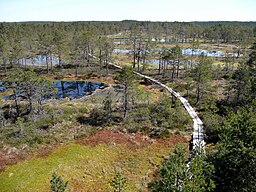Lahemaa National Park
| Lahemaa National Park (Lahemaa rahvuspark) | |
| Protected Area | |
|
Viru Bog (Estonian: Viru raba)
|
|
| Country | Estonia |
|---|---|
| Coordinates | 59°34′16″N 25°48′1″E / 59.57111°N 25.80028°ECoordinates: 59°34′16″N 25°48′1″E / 59.57111°N 25.80028°E |
| Area | 725 km2 (280 sq mi) |
| Established | 1 July 1971 |
| IUCN category | II - National Park |
| Website: Lahemaa National Park | |
Lahemaa National Park is a park located in northern Estonia, 70 kilometers east from the capital Tallinn. The Gulf of Finland is to the north of the park and the Tallinn-Narva highway (E20) is to the south. Its area covers 725 km² (including 250.9 km² of sea). It was the first area to be designated a national park of the former Soviet Union. Given its size it is the largest park in Estonia and one of Europe's biggest national parks. Its charter calls for the preservation, research and promotion of North-Estonian landscapes, ecosystems, biodiversity and national heritage.
The name Lahemaa originates from the most thoroughly studied and visited part of the North Estonian coast, where four large peninsulas (Juminda, Pärispea, Käsmu and Vergi) are separated from each other by four bays (Kolga, Hara, Eru and Käsmu.) Lahemaa translates roughly as "Land of Bays".
The national park, established in 1971, is one of the main tourism drawcards in Estonia. Several companies offer day tour packages from Tallinn, while many people drive themselves. With forests covering more than 70 percent of Lahemaa, the area is rich in flora and fauna. The landscape has many raised bogs, including the 7,000-year-old Laukasoo Reserve. The park, marked by several trails, teems with wildlife, including a population of wolves, bear and lynx.
There are four manors situated in the national park, Palmse manor, the picturesque Vihula manor, Kolga manor, and the baroque Sagadi Manor, Estonia’s most visited manor which together with the other three comprise one of the most unusual group of manors in the country.
Käsmu peninsula.
Viru Bog, located in the south of the park
Viru Bog
Sunset on Võsu beach
Valgejõgi river, flowing through the national park
...
Wikipedia


